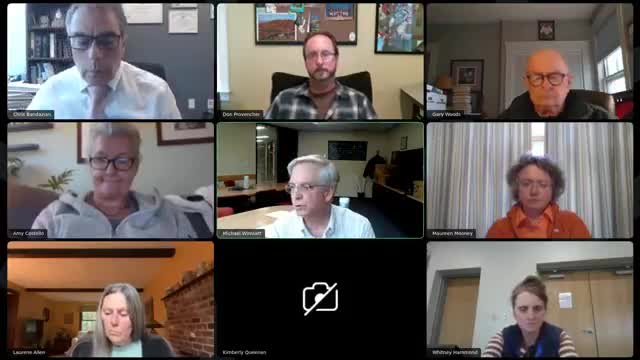Residents and commission debate soil standards and who must pay for PFAS cleanup
November 18, 2025 | Environmental Service Department, State Government Agencies, Executive, New Hampshire
This article was created by AI summarizing key points discussed. AI makes mistakes, so for full details and context, please refer to the video of the full meeting. Please report any errors so we can fix them. Report an error »

An extended exchange at the Nov. 14 commission meeting focused on soil sampling, standards and who bears responsibility for managing PFAS‑contaminated soil inside the consent‑decree boundary.
Lorraine, a commission member, criticized current approaches and urged that the responsible company be required to remove contaminated soil rather than allowing developers to find on‑site fixes. "If the people who aren't tuned in were tuned in, they would conclude what the people who are paying attention all feel...we were used as a garbage can," she said.
Mike, a DES representative, acknowledged the public frustration but said the technical and logistical scale complicates a simple removal approach. "We've got 64 plus square miles of impacted area. It represents billions and billions of cubic yards of contaminated soil," he said, adding that different soils and settings will likely require a mix of options, including disposal to authorized facilities and in some cases on‑site management or treatment technologies.
The commission discussed when developers are required to test soils. Laureen asked whether soil testing is only triggered by a large alteration‑of‑terrain permit or whether planning boards should require testing before export of soils. Mike said soils that will be excavated and taken off site generally must be characterized to ensure receiving facilities can lawfully and safely accept the material; AOT permitting thresholds and town planning conditions can also prompt sampling.
Several speakers urged DES to pursue a more enforceable, implementable approach. Lorraine pointed to a Bennington example where significant soil removal occurred after pressure; she said residents remain concerned about airborne and dust exposures and worker safety during excavation. Mike said DES has requested a more robust soil‑sampling work plan from the company and that Saint‑Gobain will have "significant responsibility" for implementing and financing solutions, but that DES is still defining what a practicable statewide paradigm looks like.
Community members also proposed research into alternative remediation methods. Wendy Thomas described a proposal to test wood‑rot‑loving fungi for PFAS uptake and said she had connected the proposer with DES and a University of New Hampshire professor; DES agreed to provide a company contact to facilitate access for a pilot plot.
The commission did not adopt new enforcement rules at the meeting; DES said it expects a revised soil‑sampling work plan from the company in 2026 and will continue to develop guidance for soil management within the consent‑decree area.
Lorraine, a commission member, criticized current approaches and urged that the responsible company be required to remove contaminated soil rather than allowing developers to find on‑site fixes. "If the people who aren't tuned in were tuned in, they would conclude what the people who are paying attention all feel...we were used as a garbage can," she said.
Mike, a DES representative, acknowledged the public frustration but said the technical and logistical scale complicates a simple removal approach. "We've got 64 plus square miles of impacted area. It represents billions and billions of cubic yards of contaminated soil," he said, adding that different soils and settings will likely require a mix of options, including disposal to authorized facilities and in some cases on‑site management or treatment technologies.
The commission discussed when developers are required to test soils. Laureen asked whether soil testing is only triggered by a large alteration‑of‑terrain permit or whether planning boards should require testing before export of soils. Mike said soils that will be excavated and taken off site generally must be characterized to ensure receiving facilities can lawfully and safely accept the material; AOT permitting thresholds and town planning conditions can also prompt sampling.
Several speakers urged DES to pursue a more enforceable, implementable approach. Lorraine pointed to a Bennington example where significant soil removal occurred after pressure; she said residents remain concerned about airborne and dust exposures and worker safety during excavation. Mike said DES has requested a more robust soil‑sampling work plan from the company and that Saint‑Gobain will have "significant responsibility" for implementing and financing solutions, but that DES is still defining what a practicable statewide paradigm looks like.
Community members also proposed research into alternative remediation methods. Wendy Thomas described a proposal to test wood‑rot‑loving fungi for PFAS uptake and said she had connected the proposer with DES and a University of New Hampshire professor; DES agreed to provide a company contact to facilitate access for a pilot plot.
The commission did not adopt new enforcement rules at the meeting; DES said it expects a revised soil‑sampling work plan from the company in 2026 and will continue to develop guidance for soil management within the consent‑decree area.
Don't Miss a Word: See the Full Meeting!
Go beyond summaries. Unlock every video, transcript, and key insight with a Founder Membership.
✓
Get instant access to full meeting videos
✓
Search and clip any phrase from complete transcripts
✓
Receive AI-powered summaries & custom alerts
✓
Enjoy lifetime, unrestricted access to government data
30-day money-back guarantee

